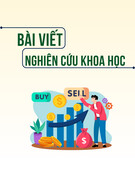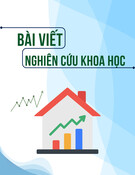
Asian Social Science; Vol. 13, No. 2; 2017
ISSN 1911-2017 E-ISSN 1911-2025
Published by Canadian Center of Science and Education
1
Changing Leadership Style in the Vietnamese Commercial Banks
Before and After Vietnam Joins the WTO
Do Minh Cuong1 & Nguyen Hai Minh1
University of Economics and Business, Vietnam National University, Hanoi, Vietnam
Correspondence: Nguyen Hai Minh, University of Economics and Business, Vietnam National University, Hanoi,
Vietnam. E-mail: nghaiminh82@gmail.com
Received: May 31, 2016 Accepted: June 8, 2016 Online Published: January 19, 2017
doi:10.5539/ass.v13n2p1 URL: http://dx.doi.org/10.5539/ass.v13n2p1
Abstract
This study seeks to examine the changes in leadership style in four state-owned commercial banks in Vietnam of
Vietcombank, Vietinbank, BIDV and Agribank before and after Vietnam joins the WTO, from 2007 to 2015. The
study used OCAI culture diagnostic models to assess four different leadership styles using questionnaires and
multivariate analysis techniques (paired t test, t test, ANOVA). The research result from 1056 employees in
Vietnamese banks shows that there is a shift in the leadership style between two periods before and after Vietnam
joins the WTO. The study also shows a significant difference in the change level of the leadership style between
banks that have increased competitive and creative factors. This conversion trend is strongly increasing as
Vietnam is about to participate in the TPP.
The study was funded by Vietnam National Foundation for Science and Technology Development (NAFOSTED)
under grant number I3-2012.21.
Keywords: Leadership style, organizational culture, commercial bank, OCAI model, bank administration
1. Introduction
Leadership style is a characteristic aspect of organizational culture and plays an important role to the
organization success. Leadership style affects organization’s performance, reputation or image (Conger &
Kanungo, 1988; Deal & Kennedy, 1982). It is also regarded as one of the most crucial factors creating the
difference in image, supporting the achievement of corporate performance as well as the achievement of strategic
objectives and maintaining the organization’s advantages (Bass, 1985). In addition, leadership style reflects the
perspectives and philosophies on organizational management in order to maximize the use of resources, achieve
the the organization’s goals, and maintain the organization’s position and image (Avolio, 1999; Quinn, 1988;
Yukl, 2010).
Points of views on leadership style vary. Leadership style does not represent talent, purpose, control art and
impacts of leadership to others (Avolio, 1999). Leadership style is considered as a system of characterized
indications of a leader defined by personality traits (Burns, 1978) or simply put as the interactive result between
personal relationships and events (Tichy & Devama, 1986). Leadership style is also seen as the combination of
subjective psychological factors and environmental factors in the management system (Schein, 1985).
Many researchers worldwide argue that in the different business stages, the nature of business or organizational
structure requires different leadership style to match with corporate cultures. The leadership styles have also
changed under the pressure from business environment due to increasing volatility in the business environment.
According Quin & Camaroon (2011), there are four leadership styles based on the corporate culture types. They
are (1) the style of guides, leaders, spiritual leaders belonging to the clan culture; (2) the style of the supervisors
and managers belonging to hierarchy culture; (3) the style of directors and commanding generals pertaining to
market culture and (4) the style of music conductors and expedition leaders pertaining to Adhocracy (Create)
culture. It should be noted that four leadership styles co-exist and each might express more obviously into a
dominant cultural style of a leader and a particular organization, depending on the business stages as well as the
business sector characteristics.
Becoming a WTO member in 2007 is a major event marking Vietnam's integration with the world economy.
Vietnam’s joining the TPP marks the next milestone of intensive, extensive and higher-level integration. The

ass.ccsenet.org Asian Social Science Vol. 13, No. 2; 2017
2
integration process brings both advantages and challenges for all businesses, including the banking sector. The
competitive pressures shall increase for the state commercial banks when the financial market is increasing;
more foreign banks enter the market and the private commercial banks is more and more developing. These
pressures require the state commercial banks (owned by the government from 51% to 100% of the shares) to
change, especially changing the organizational culture structure (Nguyen & Dao, 2015). Therefore, to survive
and thrive, the state commercial banks and businesses are expected to adapt to the business environment.
Changes in leadership style or typology of leadership have been well-researched in developed countries. In
Vietnam, despite pressures for competitiveness and pressures for changes, these issues remain under-researched.
For this reason, this study was designed to evaluate the changes of leadership style in the Vietnamese state
commercial banks and the difference in the change level of the leadership styles between the banks and the
business sector.
2. Research Overview
Leadership style is characteristics of the leadership in managing and operating the organizations. There are many
different perspectives on leadership style in organizations. Leadership style is defined as a personal characteristic
which differentiates between a leader with other people without leadership qualities (Stodgill, 1948); is
characteristic of a leader guiding the organization and is a part of the organizational culture (Harris & Ogbonna,
1999; Schein, 1985); it is the characteristic system governed by the leader’s personalities (Burns, 1978); is result
between the personal relationships and the organization’s events (Tichy & Devama, 1986) or control art, which
affects others (Avolio, 1999). Hence, the concept of the leadership style carries certain different connotations to
different researchers. In this study, we define the leadership styles based on Schein’s concept (1985) and Quin &
Camaroon (2011). Accordingly, leadership style is characteristics of management or operating work of the
leaders and it is also an attribute of the organizational culture.
Research of leadership style could be traced back to the 1950s with main theories as (1) identification theory
(Argyris, 1955; Mahoney et al, 1960; Bowsers & Seashore, 1966); (2) organization approach theory (Bowsers &
Seashore, 1966) and (3) organizational culture and leadership style theory (Schein, 1985; Ogbonna & Harris,
2000; Quin & Camaroon, 2011).
Identification theory postulates that personal characteristics formed leadership style and certain personal
characteristics shaping successful leaders (Argyris, 1955; Mahoney et al., 1960). The in-born characteristics
made the leaders different to people without leadership qualities (Stodgill, 1948). Although identification theory
helps to explain the leaders’ success based on their personal characteristics, it was criticized for not showing how
to categorize the characteristic features of successful leadership style.
Organization approach theory argues that leadership style depends on the organization’s characteristics. These
researches having used organization approach conclude that organizations in which leaders use democratic
management style shall easily achieve their strategic goals as well as greater corporate performance because this
leadership style shall prove the strength of the cohesion between collective and individuals’ creativeness
(Bowsers & Seashore, 1966).
Table 1. Summary characteristics of 4 major organizational culture types
Clan culture Hierarchy culture Market culture Adhocracy (Create)
culture
Dominant
Characteristics
Friendly and sharing
environment, Principal, hierarchy Focus on results, boost
competition
Free and dynamic
environment
Organizational
Leadership
Guides, group leaders,
spiritual leaders Supervisors, managers Directors, commanding
generals
Conductors,
expedition leaders
Management of
Employees
Cooperative,
collaborative Stable, compliant Promotive, challenging Free, creative
Organization Glue Loyalty, tradition Regulations, rules,
standards Victory, achievements Innovation,
experience
Strategic Emphases Strong team
development
Stable and steady
system Market leader Continuous
innovation
Criteria of Success Loyal and supportive
staffs
Lowest costs, highest
standards
Number one in market
share Pioneering products
Leadership style and organizational culture theory (Schein, 1985; Quin & Camaroon, 2011). Organizational
culture and leadership style are considered as the core and inseparable parts (Harris & Ogbonna, 1999).
According to Schein (1992), leadership style and organizational culture are two inseparable and

ass.ccsenet.org Asian Social Science Vol. 13, No. 2; 2017
3
intimately-related parts: leadership style is a direct result of the organizational culture, but the leadership style
have back impact to the organizational culture. Quin and Camarón (2011) state that there are four different
leadership styles corresponding with four organizational culture types: Family culture (Clan), Hierarchy culture
(Hierarchy), Competitive culture (Market) and Creative culture (Adhocracy). In addition, based on six elements
of organizational culture such as: (1) Dominant Characteristics, (2) Organizational Leadership, (3) Management
of Employees, (4) Organization Glue, (5) Strategic Emphases and (6) Criteria of Success. In particular, in Clan
culture, leaders with outstanding competencies are instructors, team and spiritual leaders; in Hierarchy culture,
leaders with outstanding competencies are the supervisors, and managers; in Market culture, leaders with
outstanding competencies are directors and commanding generals; and in Adhocracy culture, leaders with
outstanding competencies are conductors and expedition leaders (see Table 1).
Hypotheses:
Joining the WTO is a significant integration event. Along with that, financial sector also welcomes many
international banks to the Vietnamese market such as Citibank, HSBC, ANZ and so on. These newly-entered
financial institutions along with non-public banks shall create an increasing level of competitiveness to state
commercial banks. In this view, banks have to change, including changes in organizational culture and leadership
style. Therefore, this study suggests:
H1: There is change in the leadership styles of the state commercial banks before and after Vietnam had joining
the WTO. Leadership style here is understood as a component and characteristics of organizational culture,
which is more influential and enduring than a specific business leader’s behavior style.
Different banks have the different characteristics of administrative systems and different cultural forms. The
competitive level of market may affect the change trends of leadership style, but there may be differences
between the banks. Therefore, this study suggests:
H2: There are differences in the changing level in different leadership styles between banks. However, these
differences are in the framework of the 4 basic organizational culture types according to OCAI model, which
have not created a specific leadership style of Vietnam yet.
Vietnamese economic history has recognized the difference between the North and the South of Vietnam in
receiving the idea of market economy. The market economy has entered the South of Vietnam earlier, since
before 1975 (when Vietnam War ended), and only interrupted for a period of 10 years. Meanwhile, the North
developed towards economic planning of Soviet model from 1954s. Therefore, organizational culture’s dynamics,
characteristics are also marked with differences between the South and the North. Southern region has always
been considered to be more dynamic than the North. These reasons can make the change of the leadership styles
vary between the South and the North. Therefore, this study suggests:
H3. There are differences of change level in the different leadership styles between the South and the North.
3. Research Methodology
3.1 Research Design
The study was conducted through interviews with employees working at four largest state commercial banks in
Vietnam, namely Agribank, Vietcombank, BIDV and Vietinbank through a structured questionnaire. The
questionnaire aims to assess four main leadership styles and was adapted from the scale of the leadership style in
OCAI organizational culture diagnostic questionnaires of Quin & Camaroon (2011). The questions are used for
both periods before and after Vietnam joined the WTO. Total points for the four questions are identified as 10
points per a personal answer. The questions were tested through a discussion group with 10 organizational
culture specialists and revised before the official survey. Four leadership style groups surveyed include:
(1) Style of guides, group leaders, and spiritual leaders (Clan culture) with following survey questions:
A. The leadership in the organization is generally considered to exemplify mentoring, facilitating, or
nurturing.
(2) Style of conductors, and expedition leaders (Adhocracy Culture) with following survey questions:
B. The leadership in the organization is generally considered to exemplify entrepreneurship, innovation, or
risk taking.
(3) Style of directors, and commanding generals (Market culture) with following survey questions:
C. The leadership in the organization is generally considered to exemplify a no-nonsense, aggressive,
results-oriented focus.

ass.ccsenet.org Asian Social Science Vol. 13, No. 2; 2017
4
(4) Style of supervisors, managers (Hierarchy culture) with following survey questions:
D. The leadership in the organization is generally considered to exemplify coordinating, organizing, or
smooth-running efficiency.
3.2 Sample Sizes and Data Collection Methods
To ensure the study’s reliability, our expected sample size is identified as 1000. To achieve this sample size we
have delivered 1500 questionnaires. Investigation method is done by both (1) the direct survey and (2) surveys
via the internet. Direct survey is done in the bank branches in Hanoi and other areas are surveyed via the internet
through email lists of all employees who are randomly selected from the list of employees working at selected
banks. To ensure code of research, the questionnaires designed did not request name of employees in the
research. Our obtained results are 1056 valid questionnaires, including 318 questionnaires of employees working
at both the period before and after Vietnam joined the WTO.
Table 2. Breakdown of sample results
Classification criteria Number of Respondents (%)
Gender Man 456 (40.6%)
Woman 668(59.4%)
Age
< 25 80(7%)
25 - 35 992(86.7%)
35 - 45 63(5.5%)
45-55 9(0.8%)
Educational background
Intermediate / College 19(1.7%)
University 863(76.2%)
MA 247(21.8%)
PhD 3(0.3%)
Seniority at the Unit (Bank)
< 2 years 114(10%)
2 - 5 years 320(28.1%)
5 - 10 years 642(56.4%)
10 - 15 years 47(4.1%)
> 15 years 16(1.4%)
Seniority in the bank profession
< 2 years 139(12.3%)
2 - 5 years 321(28.4%)
5 - 10 years 612(54.2%)
10 - 15 years 41(3.6%)
> 15 years 16(1.4%)
Region The North 905(78.7%)
The South 245(21.3%)
Banks
Vietcombank 455(39.5%)
Agribank 153(13.3%)
BIDV 439(38.1%)
VietinBank 105(9.1%)
3.3 Data Analysis Methods
To assess the change in leadership style between the two periods before and after Vietnam joined the WTO; first
of all, we use average assessment scoring and standard deviation of the respondents in the two periods. Next, to
assess the differences happening between the two periods we use Paired t test for assessing the movement of
experienced personnel groups in both periods (Hair et al., 2006; Janssens et al., 2008; Bryman & Bell, 2015;
Field, 2009). To evaluate the differences in the change level of leadership style aspects between banks, and
between business sectors we use t-test verification (applying for two areas) and ANOVA (for comparing between
banks). Variable to compare these differences is calculated from four measuring variables of the leadership styles
according to the formula: GapK = K2 - K1. Where: GapK is the change of the leadership styles; K1 is the
assessment point of leadership styles in the periods before joining the WTO; K2 is the assessment point of the
leadership styles in the periods after joining the WTO.

ass.ccsenet.org Asian Social Science Vol. 13, No. 2; 2017
5
4. Research Results
4.1 The Leadership Style Change between the Two Periods
The analysis results from data of 1056 respondents (318 people working in both periods) showed a downward
trend in style "guides, leaders, spiritual leaders" of the Clan culture with a GPA of later stage as 2.840 (SD =
1.075) and the GPA of the period before joining the WTO as 3.189 (SD = 1.366). Similarly, the GPA of style
"conductors, expedition leaders" of Adhocracy (Create) culture also declined from 2.371 (SD = 1.003) in the
period before joining the WTO to 2.323 (SD = 0908) in the period after joining the WTO. Two leadership styles
of "supervisors, managers" and "directors, commanding generals" tend to increase. In which the style of
"supervisor, managers" of Hierarchy culture increased from 2.217 (SD = 0.655) in the period before joining the
WTO to 2.488 WTO (SD = 0874) in the period after joining the WTO; in the style of "directors, commanding
generals" of Market culture increased from 2.152 (SD = 0.692) in the period before joining the WTO to 2.338
(SD = 0.903) (Table 3; Figure 1).
Table 3. Evaluation results of the leadership styles in Vietnamese commercial banks between the two periods
Leadership style
Before joining WTO After joining WTO
Mean SD Mean SD
A. The leadership in the organization is generally considered to
exemplify mentoring, facilitating, or nurturing 3.189 1.366 2.840 1.075
B. The leadership in the organization is generally considered to
exemplify entrepreneurship, innovation, or risk taking 2.217 0.655 2.488 0.874
C. The leadership in the organization is generally considered to
exemplify a no-nonsense, aggressive, results-oriented focus 2.152 0.692 2.338 0.903
D. The leadership in the organization is generally considered to
exemplify coordinating, organizing, or smooth-running efficiency 2.371 1.003 2.323 0.908
Before joining WTO After joining WTO
Figure 1. Changing leadership styles in the Vietnamese commercial banks before and after Vietnam joins the WTO
Stabilit
y
and Control
Flexibility and Discretion
External focus
and
Differentiation
Internal
focus and
Integration
Clan Adhocrac
y
Hierarch
y
Market


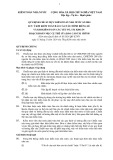

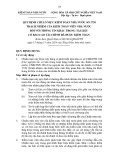
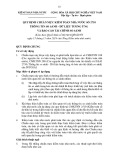
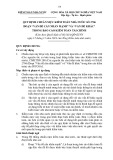



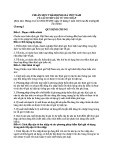

![Ngân hàng câu hỏi trắc nghiệm Lý thuyết Tài chính - Tiền tệ: Học phần [Mô tả thêm về nội dung học phần nếu có]](https://cdn.tailieu.vn/images/document/thumbnail/2025/20251003/kimphuong1001/135x160/26991759476043.jpg)
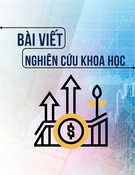
![Bài tập Tài chính doanh nghiệp có đáp án [kèm lời giải chi tiết]](https://cdn.tailieu.vn/images/document/thumbnail/2025/20250927/aimy1105nd@gmail.com/135x160/92021759119232.jpg)




